Rita and I have returned from Cuba and the Telluride Film Festival. My Hot Stove sabbatical is over. If you are a movie fan, my Telluride reviews are on Lonnie’s Jukebox. As for Cuba and getting back to Hot Stove baseball, please read on.
Cuba: We cruised from Miami to three stops in Cuba: Havana, Cienfuegos and Santiago de Cuba. General summary: friendly people, safe (no guns) and clean, but somewhat a fixer-upper. It will take some time and an end to the embargo to make Cuba a major tourist draw. Of course, it will then lose some of its charm. For now, it is an interesting time capsule made colorful by U.S. cars from the 50’s. I had a 1954 Ford in high school and a 1956 Chevy in college. Although we saw one 1954 Ford and several 1956 Chevys, we were on the bus at those times and could not get a good photo. So, we compromised with a car that was a blend of the two, a 1956 Ford Skyliner:
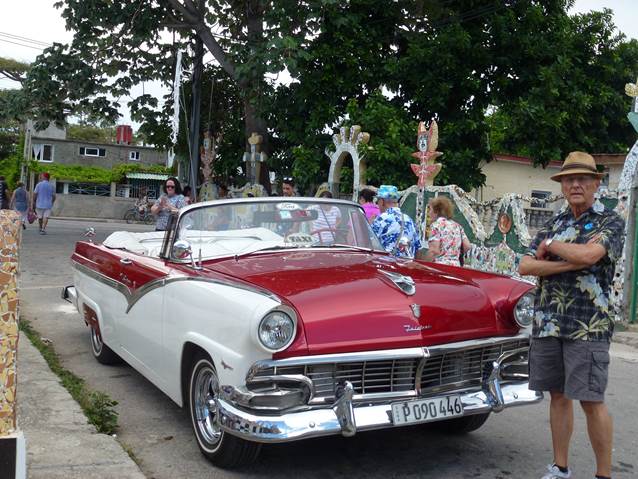
Cars are certainly not the only draw. Music. Food. History. We ate at several local restaurants, but the highlight was on my 75th birthday when our guide arranged for a cake and the house singer serenaded me with her English version of “My Way.” We tend to forget that the big revolution was in 1898, not 1959. We saw very little evidence of Fidel Castro, but a whole lot of Jose Marti, a poet, philosopher and soldier in the Spanish-American War. There are many statues of Marti and a changing of the guard every half hour at his tomb in Santiago. Also in Santiago is San Juan Hill of Teddy Roosevelt fame. If you looked only at books, posters and public displays, you would think Che Guevara led the 1959 revolution. Although the country was preparing to celebrate Fidel’s 90th birthday, the few birthday signs we saw were handmade and posted in shops. On the eve of Fidel’s birthday, we left Santiago to head back to Miami, and before we made the turn north, we passed by the lights of the U.S. base at Guantanamo. [Trivia bonus: The title to the song Guantanamera (which is heard constantly in Cuba) indicates a woman from Guantanamo. The lyrics come from a poem written in 1890 by that revolutionary, Jose Marti.]
Baseball and Cuba: Our Havana bus tour included a drive-by of the stadium where President Obama watched a game this past March. Our other touch with baseball was a visit to the Hotel Nacional de Cuba. This is the classic historic hotel in Havana that has been frequented by dignitaries and celebrities since 1930. My main knowledge about the hotel is that it was the home of the Brooklyn Dodgers for spring training in 1947. The Dodgers had trained in Florida the previous year, but General Manager Branch Rickey did not want to again subject Jackie Robinson to the Jim Crow south. Jackie had been with the Montreal farm team in 1946, and it looked like he would be in the majors in 1947. Other blacks joined the Dodgers that spring, including Roy Campanella and Don Newcombe. The major league players stayed at the opulent Nacional and the minor leaguers had good accommodations at the Havana Military Academy. Except the black players. Rickey put them in what was described as a “musty third-rated” hotel because Rickey did not want to risk any incidents as he prepared to introduce Jackie to the Brooklyn fans on opening day.
In December of 1946, just a few months before the Dodgers were in the Nacional, the “Havana Conference” was held – a meeting of the U.S. Mafia bosses to decide how to keep peace rather than fighting over territory and boss structure. A fictionalized version of this conference was in Godfather: Part II. Many of the meetings were in Room 211 as Meyer Lansky, Lucky Luciano and the others argued over gambling in Vegas and Havana, the dope trade and whether or not to kill Bugsy Siegel. That “Mafia Room” of 211 and others are still so designated if you want some history with your stay. Ava Gardner and Frank Sinatra were in Room 225. Nat King Cole was in room 208, apparently sometime after 1956 when the hotel had refused service to him.
And now we move to Stan Musial who was in Room 245. One of the bars in the hotel has a Celebrity Hall of Fame with photos of famous people who stayed there. This includes some of the mob figures who once owned part of the hotel with their secret partner, President Batista. Mickey Mantle is shown with a set of celebrities from the 50’s, and the one below from the 40’s shows Musial who barnstormed in Cuba and also played exhibition games there with the Cardinals:
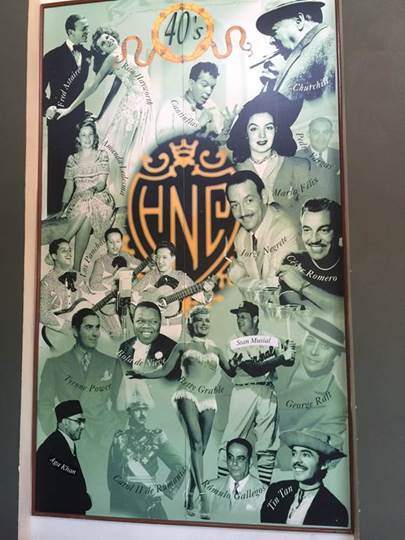
I found online a Cuba baseball card issued for Musial in 1946-47. It was from a 120-card set sold with caramels by Propagandas Montiel. It is sometimes referred to as Musial’s “rookie” card because he did not sign a deal with any U.S. card companies in his earlier years. You can check out your Spanish on the bio.
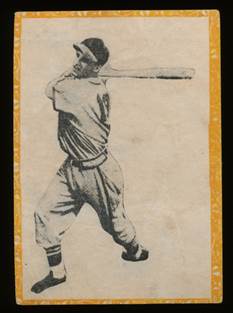
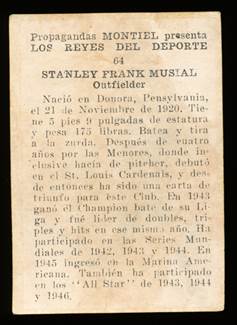
Readers’ Forum: Now for some news from Hot Stove readers:
Terry Satterlee/Mickey Mantle: The last Hot Stove post reported on Mickey Mantle’s time with the Kansas City Blues in 1951. This prompted KC lawyer Terry Satterlee to send me some trivia about Mickey’s 1950 minor league team, the Joplin (Missouri) Miners. It was fitting that Mickey would play for a team called the miners since he was raised in an Oklahoma mining family. The new trivia to me was that the Miners were owned by Terry’s uncle, Harry Satterlee. That’s Uncle Harry at the top left in this photo. Mantle is the third person from the right in the second row.

Jeb Bayer/Clint Hurdle to Raul Mondesi: Last month, Raul Mondesi at 21 years/20 days old became the youngest Royal to hit a home run since Clint Hurdle. Older Royals fans will recall that Hurdle was to be the new phenom in baseball and was called exactly that on a 1975 Sports Illustrated cover. Hurdle finished with a so-so 10-year playing career, but he has had some success over 14 seasons as manager of the Rockies and Pirates.
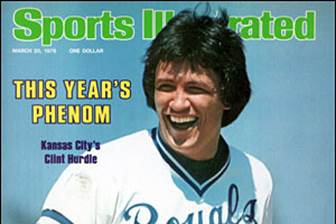
My law partner Jeb Bayer passed along this Clint Hurdle story. On September 18, 1977, playing in his first major league game, Hurdle hit a home run. He had just turned 20, and the city was buzzing about his future. After that Sunday afternoon debut game, Hurdle went to Stanford and Sons in Westport to celebrate. He ordered a drink, but the bartender refused to serve him because as everyone in town knew from the sportscasting, Hurdle was not yet 21. Hurdle was not happy and left the bar. I know this is a true story. Jeb Bayer was the bartender.
Randy Leathers/Joe DeMaestri: Randy Leathers, former KC amateur baseball player and now a resident of sunny California, sent an obituary of Joe DeMaestri who died at age 87 on August 26, 2016. When I went to the first major league game in Kansas City in 1955, DeMaestri was the shortstop for our transplanted A’s. Joe had played with the A’s in Philadelphia and made the move to KC with the team. His 11-year career included seven years with the A’s (1953-1959). After the 1959 season, he was traded with Roger Maris and Kent Hadley to the Yankees for Norm Siebern, Marv Throneberry, Hank Bauer and Don Larsen. He had a ringside seat to the 61-homer season by Roger Maris. Joe’s 1955 Bowman card:
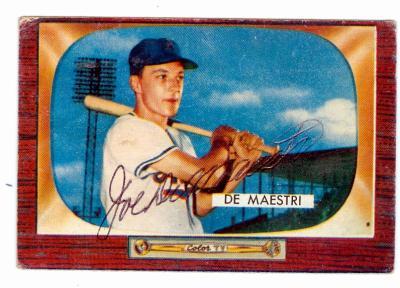
Jim Chappell/The Athletics: The trade of Maris to the Yankees is Exhibit 1 for those who believe Kansas City A’s owner Arnold Johnson gave away too much to the Yankees. There also was little love from the fans for Johnson’s successor Charlie Finley. If you want to see memorabilia from those Kansas City A’s years, head over to Chappell’s Restaurant in North Kansas City. Owner Jim Chappell is one of the few who maintained any connection with Finley after the A’s moved to Oakland. That is why you can see one of the Oakland World Series trophies behind the bar. Jim and I were at a recent event at the Plaza Library when Nancy Finley discussed her book Finley Ball. She is the daughter of Carl Finley who was Charlie’s cousin and part of the A’s administration. Library Director Crosby Kemper introduced the author and had his own boyhood stories about the Finley years because his dad was the baseball club’s banker. Kemper noted that the KC A’s are the one team in baseball history to have had only losing seasons (setting aside the expansion Seattle Pilots who only played one year before moving to Milwaukee; the KC A’s had 13 seasons).
Kemper also told a story about “Marvelous” Marv Throneberry who came to KC in the Maris trade. Throneberry moved on from KC to Baltimore and then became part of the infamous 1962 Mets – the new expansion team that caused manager Casey Stengel to say “Can’t anybody here play this game.” In a Cubs game that year, Throneberry hit a triple, but was called out after Ernie Banks took a relay throw and stepped on second base. Banks said Marv have missed second on his way to third. The umpire agreed and called Marv out. Casey Stengel came out to argue, but was told by the umpire (or the first base coach in another version of the story) to not argue – Marv had also missed first. Casey’s response was that he knows he at least touched third because he was now standing on it. The next batter hit a home run. Marv’s mistake proved costly as the Mets lost the game by one run.
Steve Jagoda/The Pathetics: The KC A’s may not have had any winning seasons, but they were nowhere close to having the worst season ever. Steve Jagoda sent me an excellent Sports Illustrated article about the Philadelphia Athletics, a/k/a the “Pathetics.” In 1916, those A’s went 36-117. This was not long after they had played in four World Series from 1910 to 1914, winning three championships. Connie Mack did not have the money to keep his stars. Sound familiar? The lengthy article gives a good and interesting history of the Philadelphia A’s, but I am only going to cover the elephant for now. For those who want more, click here.
Baseball Elephants – U.S. and Cuba: The article on the Pathetics reminded me of why the team adopted the elephant for its logo. In 1900, Connie Mack talked Ben Shibe into being his partner and buying an expansion franchise in the new American League. The league was partially made up of pre-existing teams who feared that Mack would poach their players. Legendary baseball manager John McGraw called Mack’s team a white elephant. Mack responded by having a white elephant included in the team logo – a tradition that continues to this day as you will see if you watch the Oakland A’s play the Royals this week. A good article on the long history of the A’s elephant includes this clip about the A’s elephant in KC:
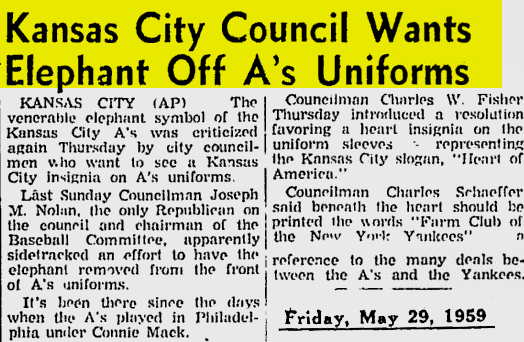
Cuba elephant? When Rita and I were on our bus tour through Cienfuegos, we rode by their baseball stadium and were somewhat surprised to see a full size elephant statue. I had heard about Cienfuegos baseball because it had one of the teams from the golden era of Cuban professional baseball (Fidel banned pro ball in 1961). Many Major Leaguers and Negro Leaguers played Cuban ball in the winter, and among those who played for Cienfuegos were Cool Papa Bell, Martin Dihigo, Sal Maglie, Camilo Pascual, Cookie Rojas and Willie Wells. I did not know that the team name was the “Elefantes.” The English translation on the logo below is “The pace of the elephant is slow but crushing.”
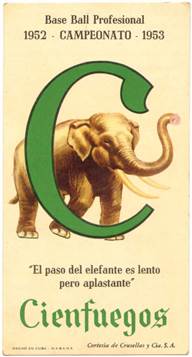
A 1956 Chevrolet is Found: After returning from Cuba, Rita and I, along with son Jason and grandson Ian, went to Kauffman Stadium to tour the traveling Hall of Fame exhibit from Cooperstown. On the Sunday we went, there was a vintage car show next to the Hall of Fame exhibit. And there it was. A 1956 Chevy that stood still for a photo. Mine was just like this except for a custom emerald green paint job.
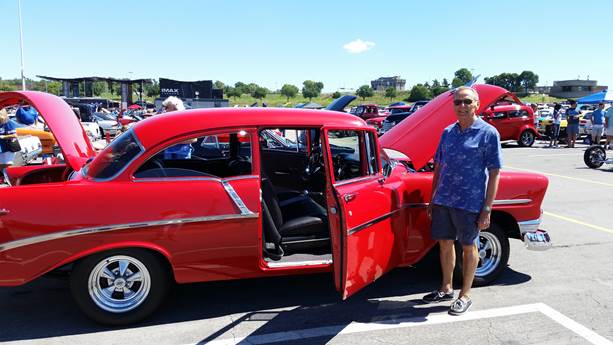
Coming Attractions: I think I will finally get to the all-time first baseman discussion in the next Hot Stove.